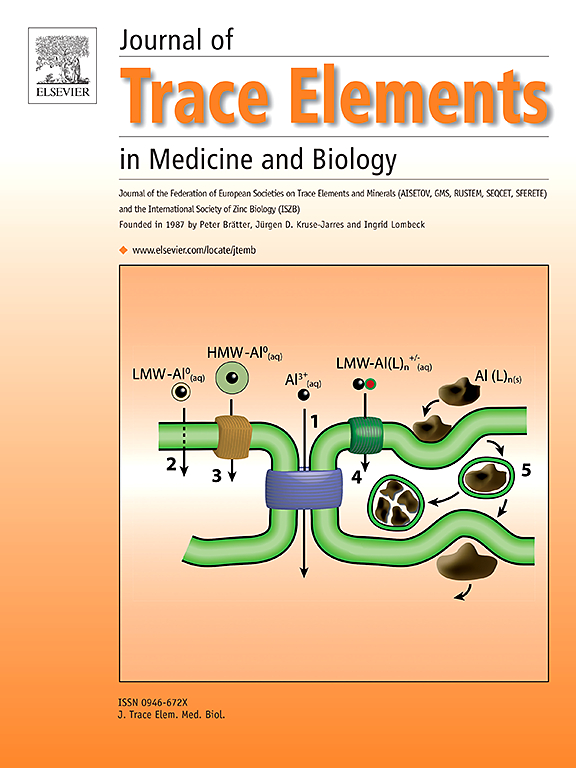日本成年人的镉摄入量和排泄量
IF 3.6
3区 医学
Q2 BIOCHEMISTRY & MOLECULAR BIOLOGY
Journal of Trace Elements in Medicine and Biology
Pub Date : 2024-09-20
DOI:10.1016/j.jtemb.2024.127535
引用次数: 0
摘要
本研究的目的是了解最近的镉摄入量和排泄量是否与 Ikeda 等人提出的回归方程(Environ.Health Prev.Med.方法在 2017-2019 年收集了 150 名日本成年人(85 名女性和 65 名男性,平均年龄为 44.9 岁)的匹配重复饮食和定点尿液样本,以估算每日镉摄入量和尿液排泄量。结果镉摄入量的几何平均数(几何标准偏差)为 12.1 (1.67) 微克/人/天或 0.206 (1.66) 微克/千克体重/天。尿液中的镉浓度为 0.54 (2.6) μg/g 肌酐或 0.67 μg/L (2.3)(重量校正)。这些数据低于之前报告的日本人群的数据。无论是肌酐校正还是重量校正,女性的尿液浓度都明显高于男性。男性的膳食摄入量高于女性,但这一差异在体重校正后有所缩小。就个体而言,镉摄入量和尿液浓度之间没有明显的相关性,这在意料之中,因为尿液中的镉浓度反映的是镉的体内负荷,而不是近期的摄入水平。同时,几何平均摄入量和尿液浓度与 Ikeda 等人提出的回归方程一致,该方程是基于对 30 个非暴露的日本女性人群的摄入量和排泄量调查得出的。本文章由计算机程序翻译,如有差异,请以英文原文为准。
Intake and excretion of cadmium of Japanese adult
Objective
It is the aim of this study if the recent Cd intake and excretion is consistent with the regression equation proposed by Ikeda et al. (Environ. Health Prev. Med. 20 (2015) 455–459) which utilized intake/excretion data of 3 decades ago
Method
Matched duplicate diet and spot urine samples were collected in 2017–2019 from 150 Japanese adults (85 females and 65 males, mean age being 44.9) for the estimation of daily Cd intake and urinary excretion. Cd concentration in diet and urine was measured by ICP mass spectrometry.
Result
Geometric mean (geometric standard deviation) of Cd intake was 12.1 (1.67) μg/person/day or 0.206 (1.66) μg/kg body wt./day. Urinary Cd concentration was 0.54 (2.6) μg/g creatinine or 0.67 μg/L (2.3) (gravimetric correction). These were lower than those reported previously for Japanese populations. Urinary concentration was significantly higher in females than in males for both creatinine and gravimetric corrections. Dietary intake was higher in males than in females but this difference diminished after body weight correction. There was no significant correlation between Cd intake and urinary concentration on individual basis, which was expected because urinary Cd concentration reflects Cd body burden but not recent intake level. Meanwhile, the geometric mean intake and urine concentration was consistent with the regression equation proposed by Ikeda et al., which was based on intake and excretion surveys for 30 non-exposed Japanese female populations.
Conclusion
This result supported that the regression equation of Ikeda et al. could be used for conversion of urinary Cd excretion level of a population to intake level.
求助全文
通过发布文献求助,成功后即可免费获取论文全文。
去求助
来源期刊
CiteScore
6.60
自引率
2.90%
发文量
202
审稿时长
85 days
期刊介绍:
The journal provides the reader with a thorough description of theoretical and applied aspects of trace elements in medicine and biology and is devoted to the advancement of scientific knowledge about trace elements and trace element species. Trace elements play essential roles in the maintenance of physiological processes. During the last decades there has been a great deal of scientific investigation about the function and binding of trace elements. The Journal of Trace Elements in Medicine and Biology focuses on the description and dissemination of scientific results concerning the role of trace elements with respect to their mode of action in health and disease and nutritional importance. Progress in the knowledge of the biological role of trace elements depends, however, on advances in trace elements chemistry. Thus the Journal of Trace Elements in Medicine and Biology will include only those papers that base their results on proven analytical methods.
Also, we only publish those articles in which the quality assurance regarding the execution of experiments and achievement of results is guaranteed.

 求助内容:
求助内容: 应助结果提醒方式:
应助结果提醒方式:


